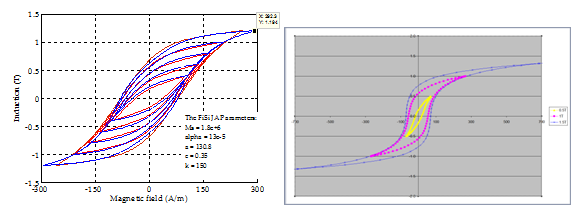Isotropic soft magnetic material: Hysteresis vector Jiles-Atherton
Introduction
In Flux, it is possible to take into account the material remanence through a material « hysteresis » model. It allows having a better accuracy, especially for iron losses computation.
The concerned applications are linear actuator, actuator with closing airgap, torus etc.

Hysteresis model in Flux
The model used in Flux is an isotropic, vector and static* Jiles-Atherton (J-A) model.
It is defined by 5 parameters entered by user. The parameters are presented in the table below.
The model is available in « magnetic transient » application in 2D and 3D.
| Parameter | Physical property |
|---|---|
| Msat | Saturation magnetization |
| a | Shape parameter for anhysteretic magnetization |
| k | Pinning coefficient |
| c | Reversible wall motion coefficient |
| α | Mean field parameter representing inter-domain coupling |
Table 1. the 5 parameters of Jiles-Atherton model
Vector J-A hysteretic model
The advantage of using vector model, comparing with the scalar model, is that it is possible to study applications with rotating flux.
The advantage of J-A model is that it is defined by only 5 parameters. Plus, the parameters are physical parameters of the material (in contrary to Preisach model, based on mathematical description).
References
The model implemented in Flux was built by Johan Gyselinck and Ruth V. Sabariego. For more technical details on the model, please consult the following two articles:
- J. Gyselinck, P. Dular, N. Sadowski, J. Leite and J.P.A. Bastos, “Incorporation of a Jiles-Atherton vector hysteresis model in 2D FE magnetic field computations – Application of the Newton-Raphson method”, COMPEL, vol. 23, no. 3, pp. 685–693, 2004.
- J. Gyselinck, L. Vandevelde, J. Melkebeek and P. Dular, “Complementary two-dimensional finite element formulations with inclusion of a vectorized Jiles-Atherton model”, COMPEL, vol. 23, no. 4, pp. 959–967, 2004.